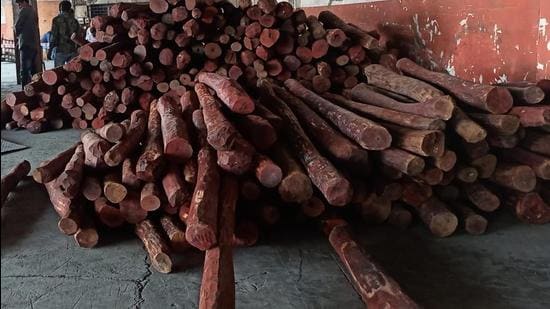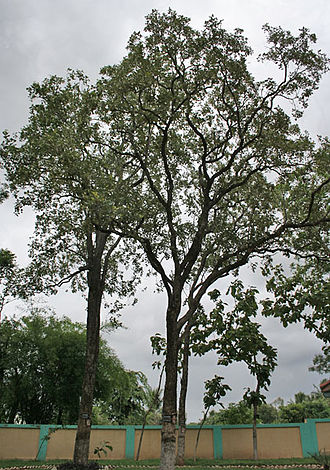The world famous Red sandalwood (Pterocarpous santalinus) is endemic to India. It can only be found in southern parts of Eastern ghats. It is small tropical tree and source of sandalwood oil found in Sheshachalam forest of Andhra Pradesh. India contributes around 90%of the total red sandalwood production in the world. It is considered as sacred and has many health benefits. The species became popular in the recent blockbuster Telugu Film “Pushpa“.

It is a small tropical tree growing in dry deciduous forest about 8 meters tall with trunk 50-150 cm in diameter. It is generally fast growing in young stage reaches up to 5 meters tall in 3 years even on degraded soil. It favours light and cannot survive in cold temperatures.
Red sandalwood is also called as Red sander, Yerra chandana, Chenchandanam, Rakt chandan, Saunderswood. Red sandalwood is rare and extremely costly. The price of one tonne of Red sandalwood is around 80 lakes to 1 crore depending upon its quality. It’s illegal to cut these trees in India. It is in huge demand.
Economic importance and health benefits:
- It is used in timber and furniture making.
- Wood at center of trunk also called as heartwood is used as medicine . Red sandalwood is used for treating digestive tract problems, fluid retention , coughs and for blood purification.
- Used as flavoring in alcoholic beverages.
- Used in making architects, crafts , instruments in China and Japan.
- Used in making cosmetic, skin care and beauty products. Very effective in reducing blemishes and achene.
It is also known for its cooling properties. It is used to cure sun tan and dullness.
Conservation status:
Red sandalwood tree is fallen under Endangered vulnerable category by IUCN (International union of Conservation of Nature). Causes are mainly over exploitation for its timber in South India. It was mentioned as near threatened in 2018. It is also listed in appendix II of CITES which mean certificate is required in order to export it that should only be granted if trade is not deter mental to survival of species.
Government declared growing sandalwood tree illegal due to rise in smuggling and exporting in recently years. Plantation is legal but undertaken away by government departments.

Why Red sandalwood is rare and forbidden ?
Red sandalwood is very expensive and used for making various stuffs. It is limited to forests in South India. People get killed in the process of smuggling. The major threat is thieves in forest.
It is legal to plant the sandalwood locally in the state like Karnataka. In fact the forest department distributes sandalwood sampling as a part of social forestry programme. We can grow Red sandalwood tree but for harvest we have to inform forest department They come and survey the tree cut it down and take it with them and pay price to owner.
The sacred Red sandalwood is important part of Indian flora. We as citizens of India have to protect them. Moreover, the timber mafia plays a crucial part in the illegal wildlife trade, which is one of humanity’s most pressing issues.
Written by: Sarvesh Bhave
Help us Help Them! Think Wildlife Foundation is a non profit organization with various conservation initiatives. Our most prominent campaign is our Caring for Pari intiative. Pari is a rehabilitated elephant at the Wildlife SoS Hospital. 25% of the profits from our store are donated to the elephant hospital for Pari. Other than buying our wonderful merchandise, you could donate directly to our Caring For Pari fundraiser.
References
- https://en.wikipedia.org/wiki/Pterocarpus_santalinus
- https://www.worldagroforestry.org/output/agroforestree-database
